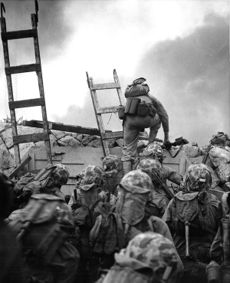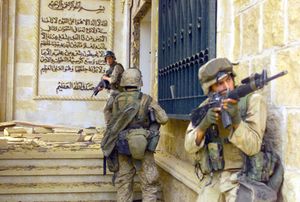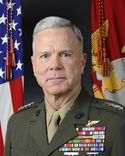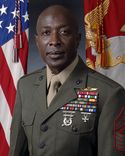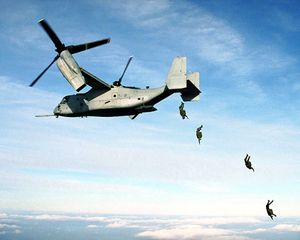قوات مشاة البحرية الأمريكية
| United States Marine Corps | |
|---|---|
| نشطة | 10 November 1775 – present |
| البلد | |
| الفرع | Marine Corps |
| النوع | Amphibious and expeditionary |
| الدور | Naval Infantry/Ground Force |
| الحجم | 202,779 active (اعتبارا من أكتوبر 2010[تحديث])[1][2] 40,000 reserve (اعتبارا من 2010[تحديث])[3] |
| جزء من | Department of Defense Department of the Navy |
| Headquarters | Headquarters Marine Corps |
| الكنية | The Few, The Proud |
| الشعار اللفظي | Semper Fidelis |
| Colors | Scarlet & Gold[4] |
| المشية | "Semper Fidelis"Play |
| جالب الحظ | English Bulldog[5][6] |
| الاشتباكات | الحرب الثورية الأمريكية Quasi-War Barbary Wars War of 1812 Seminole Wars Mexican–American War الحرب الأهلية الأمريكية Spanish–American War Philippine–American War Boxer Rebellion Banana Wars الحرب العالمية الأولى الحرب العالمية الثانية Korean War حرب ڤيتنام Gulf War Somali Civil War Kosovo War War in Afghanistan Iraq War Operation Odyssey Dawn |
| التكريمات | |
| القادة | |
| Commandant | Gen James F. Amos |
| Assistant Commandant | Gen Joseph F. Dunford, Jr. |
| Sergeant Major | SgtMaj Carlton W. Kent |
| الشارات | |
| Eagle, Globe, and Anchor |  |
قوات مشاة البحرية الأمريكية (United States Marine Corps) أو ما يعرف بالمارينز هي أحد الفروع الأربعة للقوات العسكرية الأمريكية، تخضع جزئيا لقوات البحرية (United States Navy) خاصة في الأمور غير القتالية. يعمل في سلاح مشاة البحرية الأمريكي 190،000 الف جندي في الخدمة الفعلية و40،000 الف جندي في الاحتياط. ويقع مركز قيادة في أرلينغتون بولاية فيرجينيا وتضم مكاتب القيادة والتحكم.
مهام سلاح المشاة البحري الأمريكي التعامل والتنسيق مع سلاح البحرية الأمريكية وتوصيل المعونات والأسلحة في الأزمات العالمية والاستخدام في عمليات الابرار المائية والاقتحام الساحلي والتنقل بواسطة البحرية الأمريكية وحراسة القواعد البحرية داخل وخارج الولايات المتحدة الأمريكية ومن مميزات قوات المشاء البحرية الأمريكية انهم قادرين علي العمل برا وبحرا وجواً والانتقال عبرهم.
Capabilities

التاريخ
الأصول
The United States Marine Corps traces its roots to the Continental Marines of the American Revolutionary War, formed by Captain Samuel Nicholas by a resolution of the Second Continental Congress on 10 November 1775, to raise two battalions of Marines. That date is regarded and celebrated as the date of the Marine Corps' birthday. At the end of the American Revolution, both the Continental Navy and Continental Marines were disbanded in April 1783. The institution itself would not be resurrected until 11 July 1798. At that time, in preparation for the Quasi-War with France, Congress created the United States Marine Corps.[7] Marines had been enlisted by the War Department as early as August 1797[8] for service in the new-build frigates authorized by the Congressional "Act to provide a Naval Armament" of 18 March 1794,[9] which specified the numbers of Marines to recruit for each frigate.
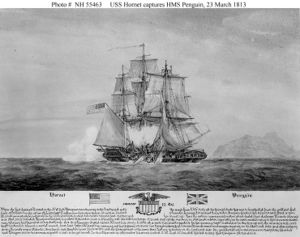
The Marines' most famous action of this period occurred during the First Barbary War (1801–1805) against the Barbary pirates,[10] when William Eaton and First Lieutenant Presley O'Bannon led eight Marines and 500 mercenaries in an effort to capture Tripoli. Though they only reached Derna, the action at Tripoli has been immortalized in the Marines' hymn and the Mameluke sword carried by Marine officers.[11]
During the War of 1812, Marine detachments on Navy ships took part in some of the great frigate duels that characterized the war, which were the first and last engagements of the conflict. Their most significant contribution, however, was holding the center of General Jackson's defensive line at the Battle of New Orleans, the final major battle and one of the most one-sided engagements of the war. With widespread news of the battle and the capture of HMS Cyane, HMS Levant and HMS Penguin, the final engagements between British and American forces, the Marines had gained a reputation as expert marksmen, especially in defensive and ship-to-ship actions.[11]
After the war, the Marine Corps fell into a malaise that ended with the appointment of Archibald Henderson as its fifth Commandant in 1820. Under his tenure, the Corps took on expeditionary duties in the Caribbean, the Gulf of Mexico, Key West, West Africa, the Falkland Islands, and Sumatra. Commandant Henderson is credited with thwarting President Jackson's attempts to combine and integrate the Marine Corps with the Army.[11] Instead, Congress passed the Act for the Better Organization of the Marine Corps in 1834, stipulating that the Corps was part of the Department of the Navy as a sister service to the Navy.[12] This would be the first of many times that the independent existence of the Corps was challenged.

Commandant Henderson volunteered the Marines for service in the Seminole Wars of 1835, personally leading nearly half of the entire Corps (two battalions) to war. A decade later, in the Mexican–American War (1846–1848), the Marines made their famed assault on Chapultepec Palace in Mexico City, which would be later celebrated as the "Halls of Montezuma" in the Marines' hymn. In the 1850s, the Marines would see further service in Panama and Asia, attached to Matthew Perry's East India Squadron on its historic trip to the Far East.[13]

The Marine Corps played a small role in the Civil War (1861–1865); their most prominent task was blockade duty. As more and more states seceded from the Union, about a third of the Corps' officers left the United States to join the Confederacy and form the Confederate States Marine Corps, which ultimately played little part in the war. The battalion of recruits formed for the First Battle of Bull Run (First Manassas) performed poorly, retreating with the rest of the Union forces.[14] Blockade duty included sea-based amphibious operations to secure forward bases. In late November 1861, Marines and sailors landed a reconnaissance in force from the يوإسإس Flag at Tybee Island, Georgia, to occupy the Lighthouse and Martello Tower on the northern end of the island. It would later be the Army base for bombardment of Fort Pulaski.[15]
الحرب العالمية الأولى
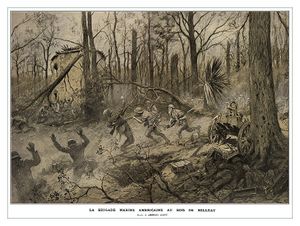
الحرب العالمية الثانية
الحرب الكورية
الحرب على الإرهاب
العملية حرية العراق
Personnel
Leadership
Rank structure
Commissioned Officers
| US DoD Pay Grade | O-1 | O-2 | O-3 | O-4 | O-5 | O-6 | O-7 | O-8 | O-9 | O-10 |
|---|---|---|---|---|---|---|---|---|---|---|
| Insignia | ||||||||||
| Title | Second Lieutenant | First Lieutenant | Captain | Major | Lieutenant Colonel | Colonel | Brigadier General | Major General | Lieutenant General | General |
| Abbreviation | 2ndLt | 1stLt | Capt | Maj | LtCol | Col | BGen | MajGen | LtGen | Gen |
| NATO Code | OF-1 | OF-2 | OF-3 | OF-4 | OF-5 | OF-6 | OF-7 | OF-8 | OF-9 | |
Warrant Officers
Warrant Officers are primarily former enlisted experts in a specific specialized field, and provide leadership generally only within that speciality.
| US DoD Pay Grade | W-1 | W-2 | W-3 | W-4 | W-5 |
|---|---|---|---|---|---|
| Insignia | |||||
| Title | Warrant Officer 1 | Chief Warrant Officer 2 | Chief Warrant Officer 3 | Chief Warrant Officer 4 | Chief Warrant Officer 5 |
| Abbreviation | WO1 | CWO2 | CWO3 | CWO4 | CWO5 |
| NATO Code | WO-1 | WO-2 | WO-3 | WO-4 | WO-5 |
Enlisted
| US DoD Pay grade | E-1 | E-2 | E-3 | E-4 | E-5 | E-6 | E-7 | E-8 | E-9 | ||||
|---|---|---|---|---|---|---|---|---|---|---|---|---|---|
| Insignia | No Insignia | 
|

|

|

|

|

|

|

|

| |||
| Title | Private | Private First Class |
Lance Corporal |
Corporal | Sergeant | Staff Sergeant |
Gunnery Sergeant |
Master Sergeant |
First Sergeant |
Master Gunnery Sergeant |
Sergeant Major |
Sergeant Major of the Marine Corps | |
| Abbreviation | Pvt | PFC | LCpl | Cpl | Sgt | SSgt | GySgt | MSgt | 1stSgt | MGySgt | SgtMaj | SgtMajMarCor | |
| NATO Code | OR-1 | OR-2 | OR-3 | OR-4 | OR-5 | OR-6 | OR-7 | OR-8 | OR-9 | ||||
Initial training
Every year, over 2,000 new Marine officers are commissioned, and 38,000 recruits accepted and trained.[14] All new Marines, enlisted or officer, are recruited by the Marine Corps Recruiting Command.
الزي
الثقافة
As in any military organization, the official and unofficial traditions of the Marine Corps serve to reinforce camaraderie and set the service apart from others. The Corps' embrace of its rich culture and history is cited as a reason for its high esprit de corps.[16]
Official traditions and customs
Unofficial traditions and customs
Equipment

Infantry weapons
The basic infantry weapon of the Marine Corps is the M16 assault rifle family, with a majority of Marines being equipped with the M16A2 or M16A4 service rifles (the M16A2 is being phased out). The M4 carbine, a compact variant of the M16, has also been issued.[17] The standard side arm is the M9 pistol. Suppressive fire is provided by the M249 SAW and M240 machine guns, at the squad and company levels respectively. In addition, indirect fire is provided by the M203 grenade launcher in fireteams, M224 60 mm mortar in companies, and M252 81 mm mortar in battalions. The M2 .50 caliber heavy machine gun and MK19 automatic grenade launcher (40 mm) are available for use by dismounted infantry, though they are more commonly vehicle-mounted. Precision firepower is provided by the M40 sniper rifle and M82 anti-materiel rifle by Scout Snipers, while designated marksmen use the DMR (being replaced by the M39 EMR), and the SAM-R.[18]
الطائرات
انظر أيضاً
- Five paragraph order
- General Orders for Sentries
- Iron Mike
- Marine (military)
- United States Marine Corps Women's Reserve
الهامش
- ^ "Marine Corps Almanac" (PDF). Concepts & Programs. United States Marine Corps. 2010: pp. 266–279. January 2010. Retrieved 2010-04-26.
{{cite journal}}:|pages=has extra text (help) - ^ "Armed Forces Strength Figures for October 31, 2010" (PDF). Military Personnel Statistics: Active Duty Military Strength by Service. U.S. Department of Defense. October 2010. Retrieved 13 December 2010.
- ^ "Reserve Force Figures" (PDF). The Continental Marine Magazine - Almanac 2010. Marine Forces Reserve. 2010. p. 9. Retrieved 27 December 2010.
The Selected Marine Corps Reserve has approximately 39,600 Marines; the Individual Ready Reserve has approximately 60,000 Marines.
- ^ Lejeune, Major General John A (18 April 1925). "Marine Corps Order No. 4 (Series 1925)". Commandant of the Marine Corps. United States Marine Corps History Division. Retrieved 2 February 2010.
- ^ Loredo-Agostini, Sgt Heidi E. (30 July 2009). "Ready for the Corps: Marines recruit latest mascot from South Texas". Recruiting Station San Antonio. Castroville, Texas: United States Marine Corps. Retrieved 22 December 2010.
- ^ Dobbs, LCpl Chris (25 July 2008). "Marine Barracks' mascot, Chesty the XII, retires after more than 40 'dog years' of faithful service". Marine Barracks, Washington, D.C.: United States Marine Corps. Retrieved 22 December 2010.
- ^ U.S. Congress (11 July 1798). "An Act for Establishing and Organizing a Marine Corps".
- ^ Captain John Barry (9 February 1798). "Muster Roll of Officers, Petty Officers, Seamen, and Marines, on the Frigate United States". Retrieved 16 May 2009.
- ^ U.S. Congress (18 March 1794). "Act to provide a Naval Armament". NARA. Retrieved 16 May 2009.
- ^ Richard Leiby, Terrorists by Another Name: The Barbary Pirates, The Washington Post, 15 October 2001
- ^ أ ب ت Simmons, Edwin H. (2003). The United States Marines: A History, Fourth Edition. Annapolis, Maryland: Naval Institute Press. ISBN 1-59114-790-5.
- ^ U.S. Congress (30 June 1834). "An Act for the Better Organization of the United States Marine Corps". Archived from the original on 7 October 2010. Retrieved 3 August 2008.
{{cite web}}: Unknown parameter|deadurl=ignored (|url-status=suggested) (help) - ^ Moskin, J. Robert (1987). The U.S. Marine Corps Story. New York: McGraw-Hill.
- ^ أ ب خطأ استشهاد: وسم
<ref>غير صحيح؛ لا نص تم توفيره للمراجع المسماةChenowethNihart - ^ Elliott, Daniel T. (2008). "Archaeological Reconnaissance at the Drudi Tract, Tybee Island, Chatham County, Georgia" (PDF). Savannah, Georgia: LAMAR Institute Publication Series. p. 9. Archived from the original (PDF) on 1 October 2011. Retrieved 7 October 2011.
{{cite web}}: Unknown parameter|deadurl=ignored (|url-status=suggested) (help) - ^ خطأ استشهاد: وسم
<ref>غير صحيح؛ لا نص تم توفيره للمراجع المسماةEstes - ^ "Top Marine Glad to Have M16A4 Standard". Kit Up!. Military.com. Retrieved 27 April 2010.
{{cite web}}: Cite has empty unknown parameters:|1=and|coauthors=(help) - ^ "M40A1 Sniper Rifle". USMC Fact File. U.S. Marine corps. Archived from the original on 25 February 2007. Retrieved 3 August 2008.
{{cite web}}: Cite has empty unknown parameter:|coauthors=(help)
![]() This article incorporates public domain material from websites or documents of the United States Marine Corps.
This article incorporates public domain material from websites or documents of the United States Marine Corps.
وصلات خارجية
- CS1 errors: extra text: pages
- CS1: Julian–Gregorian uncertainty
- CS1 errors: unsupported parameter
- مقالات فيها عبارات متقادمة منذ أكتوبر 2010
- جميع المقالات التي فيها عبارات متقادمة
- مقالات فيها عبارات متقادمة منذ 2010
- Articles with hatnote templates targeting a nonexistent page
- Articles with hAudio microformats
- Wikipedia articles incorporating text from the United States Marine Corps
- United States Marine Corps
- Uniformed services of the United States
- Military units and formations established in 1775
- بحرية الولايات المتحدة


